After migration madness has moved on and fall leaves have fallen, the crisp air and clear skies are inherited by one of our most conspicuous winter birds: the blue jay. Often curious and bold, these bright blue birds are busy preparing for winter by caching nuts and fattening up on seeds and insects. Their loud, raspy calls draw attention to their somewhat aggressive mannerisms as they compete for resources and attempt to dominate at backyard feeders. Known for their intelligence, they can be clever, adaptive and even cunning when it comes to food collection and social behavior. A close observer will bear witness to the fascinating, eccentric and exciting lives of the boisterous blue jay.
More Backyard Birds: Warblers | American Goldfinches | Hummingbirds | American Kestrels | Northern Flickers | Owls | Woodpeckers
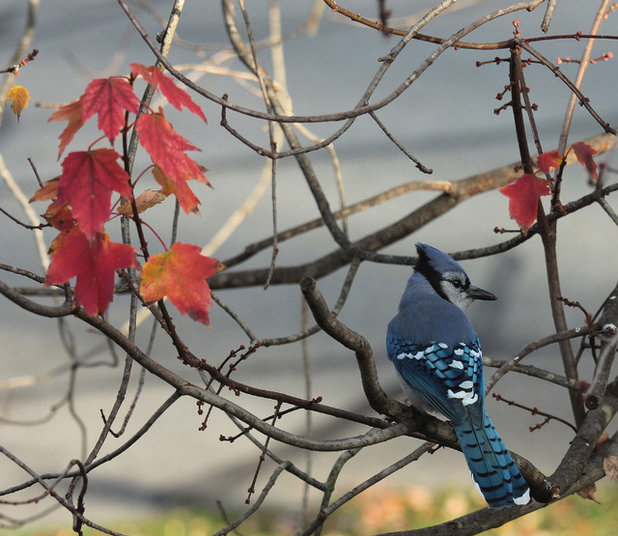 Shown:
Shown: Blue jay in a red maple (
Acer rubrum)
Photo by fishhawk
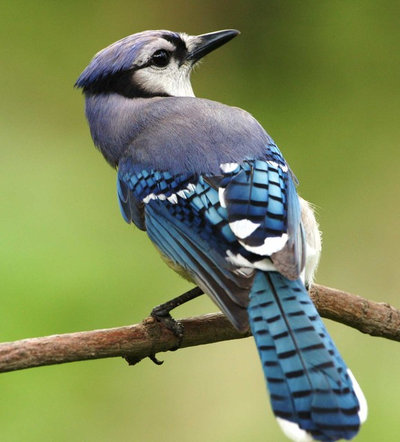 Family:
Family: Corvidae, along with crows and magpies
Common and scientific name: Blue jay (
Cyanocitta cristata), Steller’s jay (
C. stelleri), western scrub-jay (
Aphelocoma californica), pinyon jay (
Gymnorhinus cyanocephalus)
Shown: Blue jay
Photo by the U.S. Fish and Wildlife Service Northeast Region
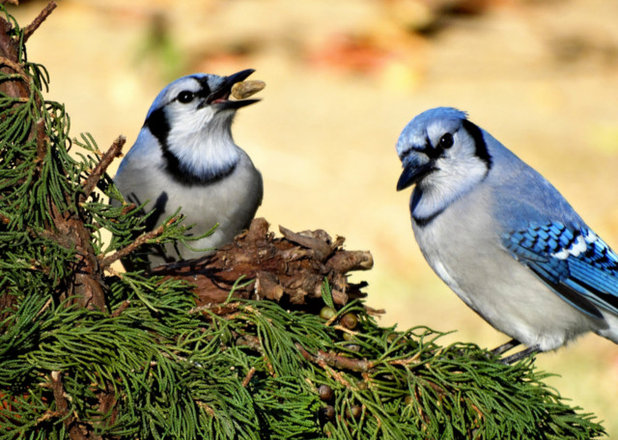
KoolPix aka J Diaz
Distribution: Blue jays are the most common and widespread jay; they’re found east of the Rocky Mountains and occasionally into the Northwest during fall and winter.
If you don’t live where blue jays are residents, there’s a good chance you’ll find other jays that are blue wherever you are. The Steller’s jay is common throughout the western half of the U.S. in higher elevations and remote forests. The western scrub-jay has a similar range in the West but will be found at lower elevations. The pinyon jay can be spotted in more rugged terrain throughout the western U.S., harvesting and caching pine seeds in the sagebrush and chaparral on lower mountain slopes.
Shown: Blue jays in an eastern red cedar (
Juniperus virginiana)
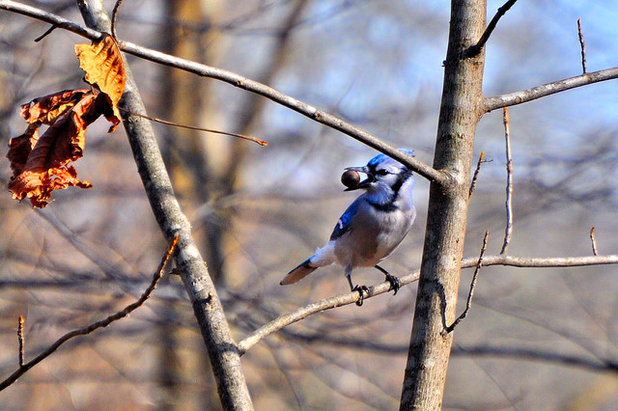 Habitat:
Habitat: Trees, especially oaks, are the most important feature of blue jay habitat. The birds prefer deciduous or mixed forest edges and woodlots where they can find plenty of acorns, one of their favorite foods.
Shown: Blue jay with an acorn in a bitternut hickory (
Carya cordiformis)
Learn more about growing trees in your yard
Photo by Tom
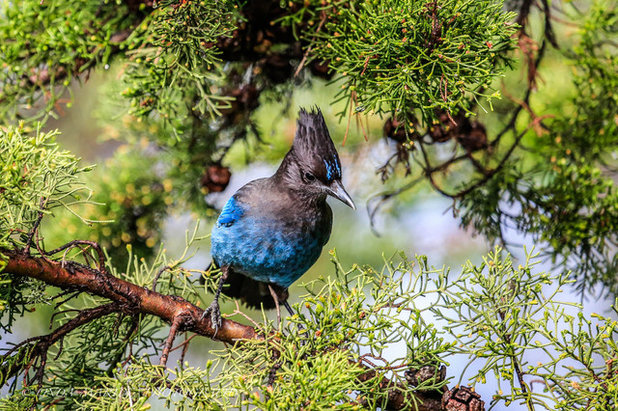
Steller’s jays, like the one pictured here in a cypress, also prefer forest edges but are more likely found in coniferous or mixed coniferous forests.
Western scrub-jays and pinyon jays both get their names from their preferred habitat. The western scrub-jay is commonly found in open scrub oak, brush and chaparral, while the pinyon jay is named for the pinyon pine (
Pinus edulis) it shares a close mutualism with in the pinyon-juniper woodlands it calls home.
Jays are opportunistic. They’re frequent visitors to backyard feeders and recreational areas, like parks and campgrounds, where there are plenty of handouts and unguarded picnic items.
When to look for them: All these jays can be seen year-round. They can be more obvious in the winter, when they’re very active and one of the few birds remaining in North America.
Photo by Linda Martin
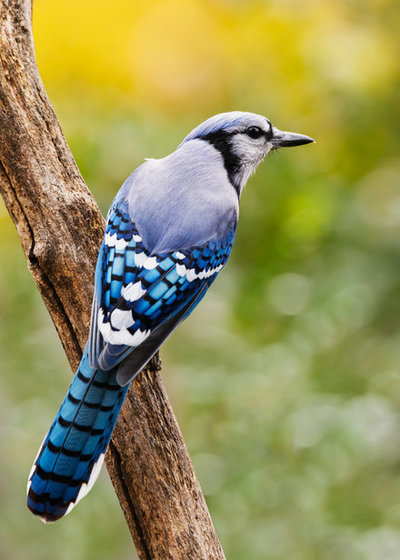 How to Identify ThemBlue jays:
How to Identify ThemBlue jays: Blue jays are not actually blue. The pigment in their feathers is melanin, which is brown. The blue color you see is a result of light interacting with both the melanin and a modified physical structure on the barb, a branch off the main shaft of the feather. This mechanism explains a lot of birds’ bright and iridescent coloration.
Blue jays have an impressive pattern of light and dark blues separated by black stripes and white patches along the wings and tail. They have a deep blue back with a white or gray underside. Blue jays have a black bridle — a stripe that traverses the throat, nape and face. It’s unique to each blue jay and may be used to help recognize one another.
They are large songbirds with thick and powerful bills, bristle feathers around the nostrils, and a tall blue crest that can be raised or lowered depending on their mood. The crest is often raised in times of aggression or heightened attention and lowered when at rest or feeding young.
Photo by Shenandoah National Park
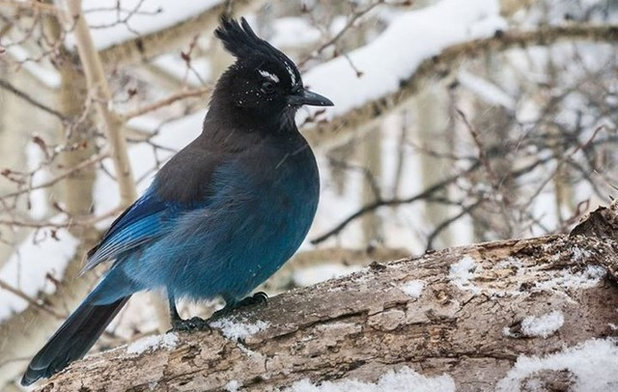
Mindy Musick King
Steller’s jays: Other (blue) jays are similar in size and coloring. Steller’s jays are the only other jay with a crest; it’s generally black with blue or white streaking on the forehead. They lack the white belly of many other jays, and the black to dark blue head and shoulders transition to an indigo body, wings and tail, giving them a beautiful ombré coloration.
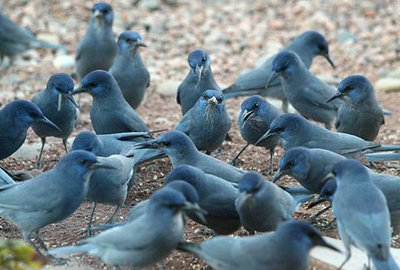
David F. Smith
Pinyon jays: Pinyon jays also lack the white belly and are completely blue with a little white streaking on the throat. Their scientific name,
Gymnorhinus, means “naked nostrils” and refers to the lack of bristle feathers at the base of the long spiky bill. They’re one of the most social jays and often found in very large flocks. Pinyon jays are shorter than other jays.
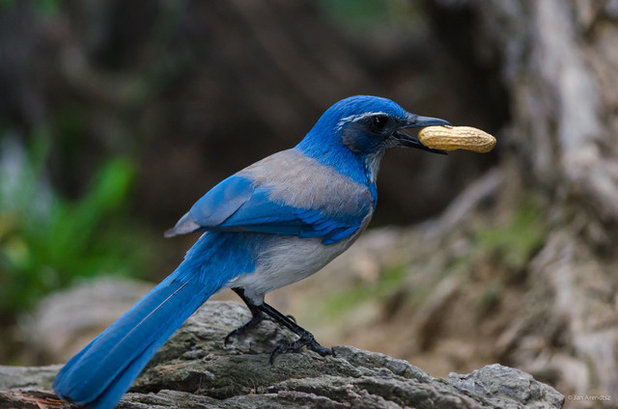 Western scrub-jays:
Western scrub-jays: Western scrub-jays can be distinguished by the deep azure head, highlighted with a bright white eyebrow, gray patches on the cheeks and back, and a white throat bordered with a blue necklace. Neither the pinyon jay nor the western scrub-jay possesses the regal crest of the blue jay and Steller’s jay.
Photo by Jan Arendtsz
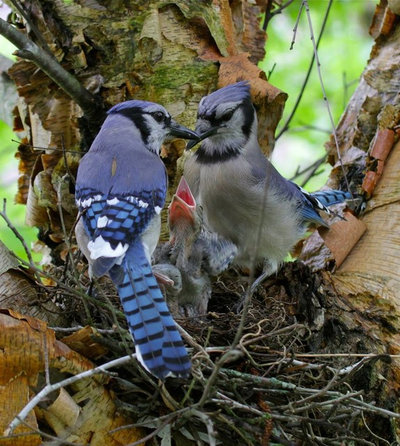
David Magers
Differences between females and males: There are no visual differences in the physical markings between male and female jays. Observing their activity, especially during mating season, is the easiest way to distinguish the sexes.
On average, in mating season, blue jay males do more material gathering, and females do more nest building. Only females incubate the eggs, while males gather food for them and the nestlings. The female will begin to gather food after eight to 10 days of brooding, but the male will continue to do most of the gathering.
Shown: Nesting male and female blue jays in a birch tree
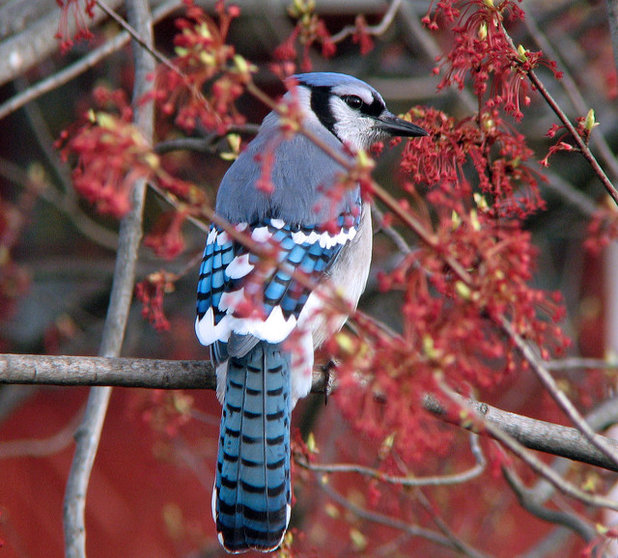 How to Attract JaysFill feeders with nuts, seeds and small fruit.
How to Attract JaysFill feeders with nuts, seeds and small fruit. All jays eat seeds, nuts and small fruit. They eat a lot of insects too, gleaned from the bark and blossoms of trees and shrubs. Jays have also been known to eat small reptiles, mammals, eggs and young nestlings, but only rarely. They will frequently visit yards with sunflower seeds or peanuts in bird feeders, suet in cages and oak trees that border large open areas.
Shown: Blue jay in red maple blossoms
Photo by fishhawk
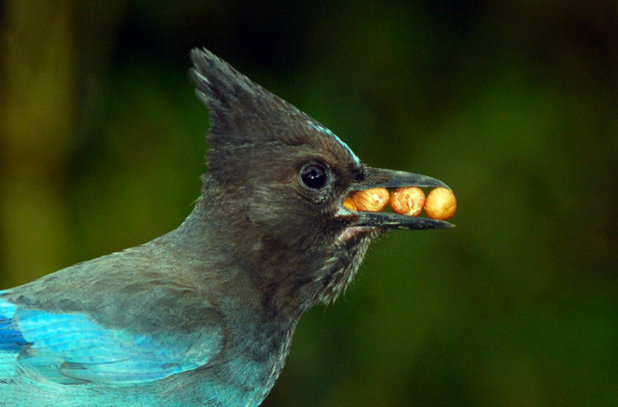
Lorcan Keating
Blue jays and Steller’s jays both love acorns and peanuts. They can pack several in the gular (throat) pouch, several more in the mouth and one more in the bill, carrying them off to cache in hidden nooks and crannies. A single blue jay will move and cache thousands of acorns per season; the ones never recovered have been credited with aiding the northern expansion of oaks after the last glacial period.
Use a platform feeder or mounted feeder to provide peanuts or sunflower seeds since jays are less likely to visit hanging feeders. Jays will use birdbaths and other water sources in yards.
Shown: A Steller’s jay with peanuts
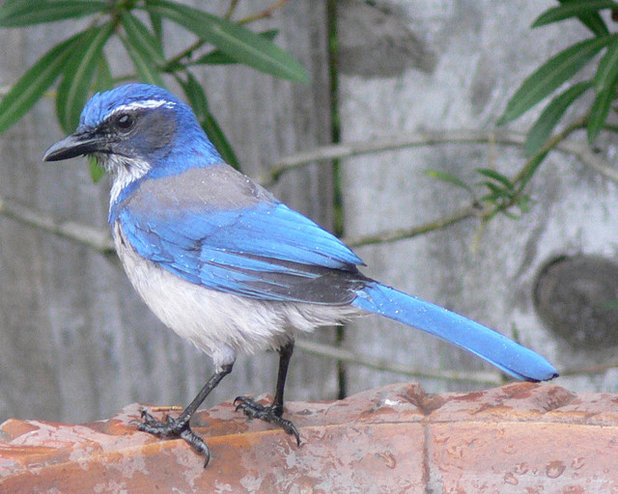 Plant native trees and shrubs.
Plant native trees and shrubs. Planting native oaks, pines and flowering shrubs on your property will provide jays with fruit and seeds while attracting the insects they eat and need to feed to their young.
Shown: A western scrub-jay on a birdbath
Browse plants native to your region
Photo by Jessica Merz
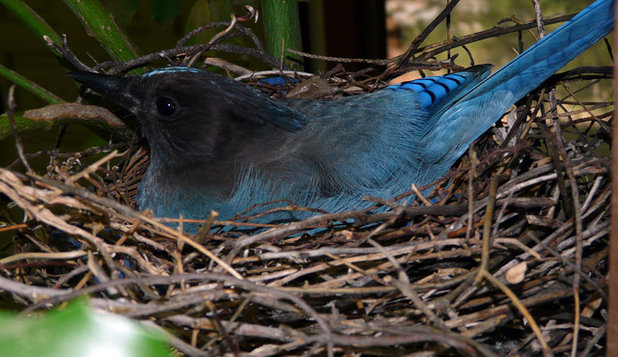
Bob White
Blue jays, like most jays, build open cup nests made mostly of sticks and twigs, sometimes incorporating grass and mud. They build their nests in the crotch of a tree 10 to 25 feet above the ground. Blue jays may line the nest with rootlets collected from fallen trees or even freshly dug ditches and graves. The female lays two to seven eggs per clutch and incubates them for about 17 days.
Shown: Female Steller’s jay on a nest
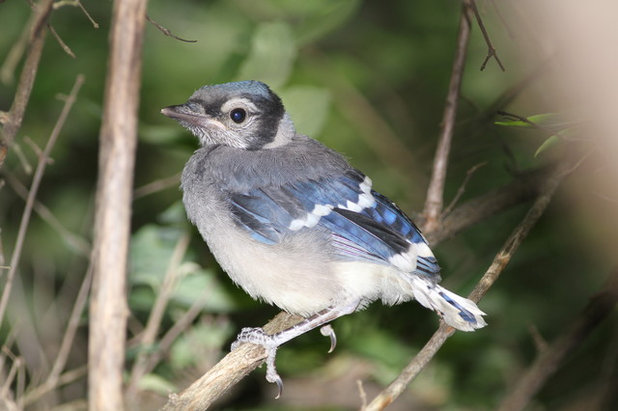
Kevin McGowan, Cornell Lab of Ornithology
About two weeks after hatching, curious young blue jays, like the one shown here, may start to explore around the nest for a few days before fledging. It may be as long as two months after leaving their nest before the fledglings become independent. They will follow closely and rely on their parents to learn how to find food and stay safe. Blue jay parents mate for life and produce only one clutch per year.
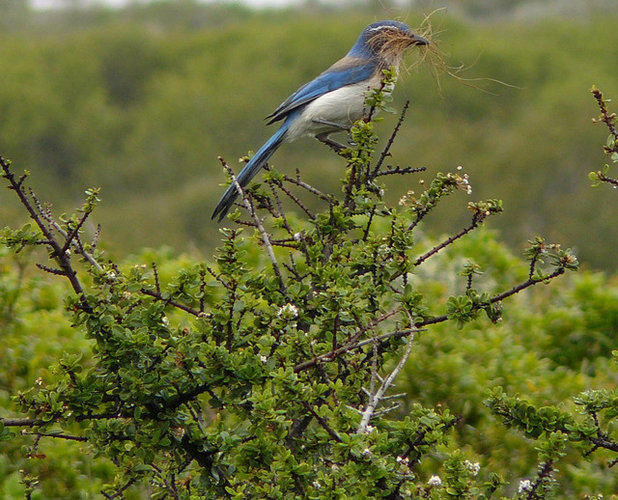
Joyce Cory
Other jays, like this western scrub-jay, may line their nests with soft fibers, grass or animal hair.
Typically, both parents will help select a nesting spot, and both will help build. Although blue jays prefer deciduous trees, other jays tend to make nests in conifer trees or large shrubs that are heavily branched and hidden from view. Nests usually take a jay about 10 days to build.
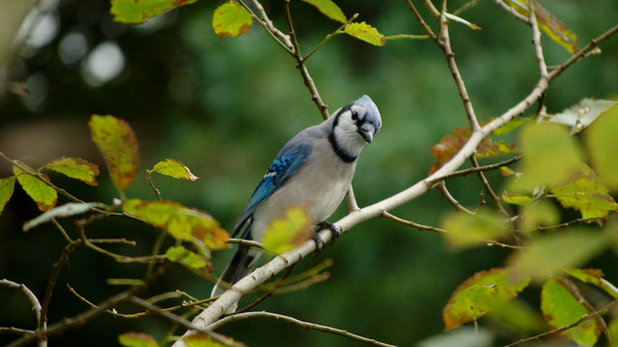 Quirky Blue Jay Behavior
Quirky Blue Jay BehaviorAlthough they are a fairly common and conspicuous bird, blue jays are still somewhat mysterious. They are the only jay to migrate in North America, but their migration patterns are inconsistent or even nonexistent some years. Generally, less than 20 percent of an area’s blue jay population will migrate, but only short distances and within their normal year-round range.
Photo by Kristin “Shoe” Shoemaker
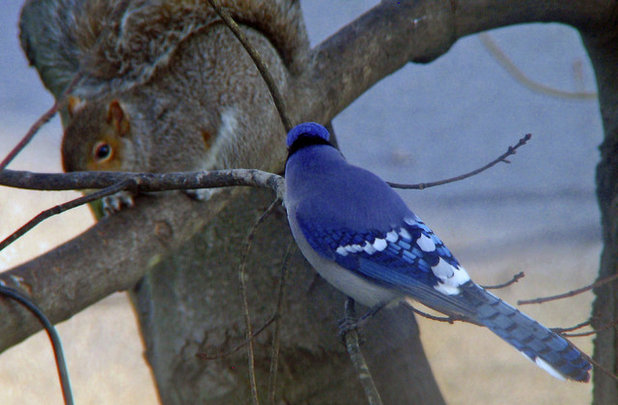
Blue jays have a wide range of vocalizations and are fairly good mimics that can imitate human speech and cat meows in captivity, where many are raised and studied by researchers. In the wild, they will imitate red-shouldered and red-tailed hawks to successfully engage in kleptoparasitism, the stealing of food from other animals. The jay will stalk and spy on small mammals, like squirrels and chipmunks, that are storing nuts and acorns for the winter. It then will imitate a hawk call, scaring away the unwary rodent that leaves the goods for the impostor to steal.
Photo by fishhawk
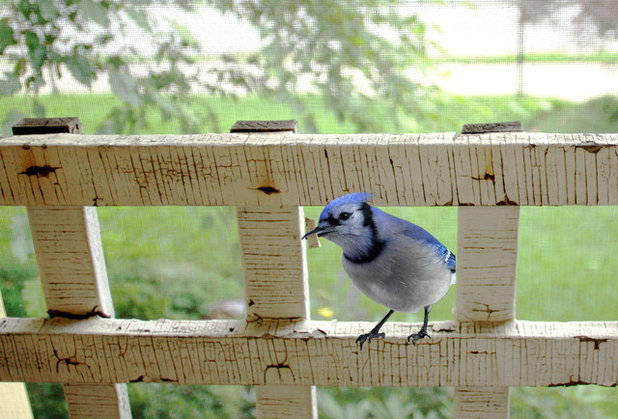
Habitat Network: The Cornell Lab of Ornithology
Another unusual behavior observed recently of blue jays in the Northeast is the peeling and eating or storing of paint chips taken from the sides of houses. Often occurring in the winter, this activity may be a way to access the calcium contained in paint; calcium is needed in the spring to support egg laying. Providing sterilized (boiled or baked) crushed egg shell (also high in calcium) outside in a bowl has been shown to stop blue jays from chipping away at house paint.
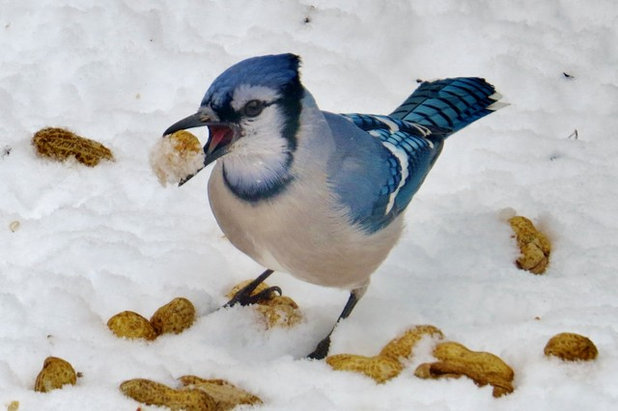
Jays are some of the most interesting characters in the bird world if you take the time to observe and appreciate their quirky and eccentric behavior. Visit All About Birds to discover more jays across North America. Also see All About Feathers for more insight into a blue jay’s colors, crest and other specialized feathers birds possess.
YardMap is a citizen science project developed by the Cornell Lab of Ornithology, designed to cultivate a richer understanding of bird habitat, for both professional scientists and people concerned with their local environment. Thousands of people are documenting their conservation efforts at home to support birds and other wildlife in their yards.Photo by Joyce Wagner





